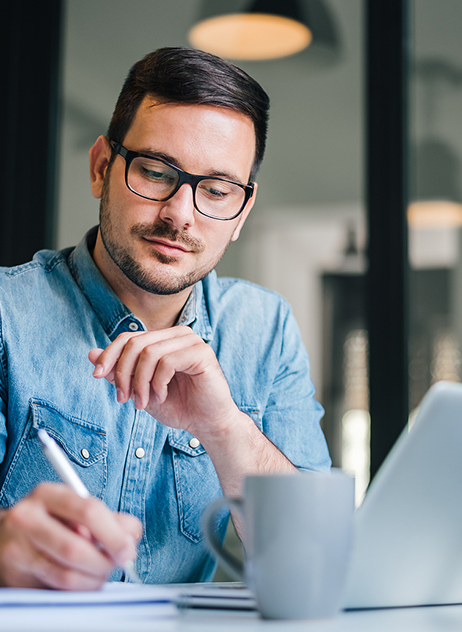Unlocking the Mystery Behind Email Marketing for Apartments
Email marketing is one of the most effective and cost-efficient ways for apartment communities to reach their residents and grow their email lists. Email marketing lets you stay in touch with your residents, keep them informed about special events or promotions, and increase resident loyalty.

It’s also an incredibly valuable tool for engaging potential renters who may be interested in leasing in your community. However, email marketing success depends on various factors, including open rates, click-through rates (CTRs), content quality, email design, subject lines, and more.
In this blog post, we’ll discuss our top email marketing best practices so that you can maximize engagement from your current residents as well as attract new ones.
1. Grow your email subscriber list with lead forms.
Email list growth is key to successful email marketing. You should always use opt-in apartment lead generation forms to encourage people to join your email list. This can be done through various channels, such as email blasts, social media posts, and website CTAs. Additionally, you can work with an email marketing agency that will help you maximize the effectiveness of your campaigns.
The best way to earn a new email is to offer the person something valuable in exchange. For example, an eBook, guide, checklist, or another valuable downloadable offer can be offered in exchange for their email.
Want to see this in action? Check out our CTA button below! You can click the landing page to see how we have this offer presented, along with our lead capture form.
2. Segment your email list.
Another email marketing tip that can be used to increase engagement is segmenting your email list. By creating tailored messages for different audiences within your email list, you can optimize the content of each email to better suit each audience’s needs. This can result in higher open rates and more relevant content being sent out.
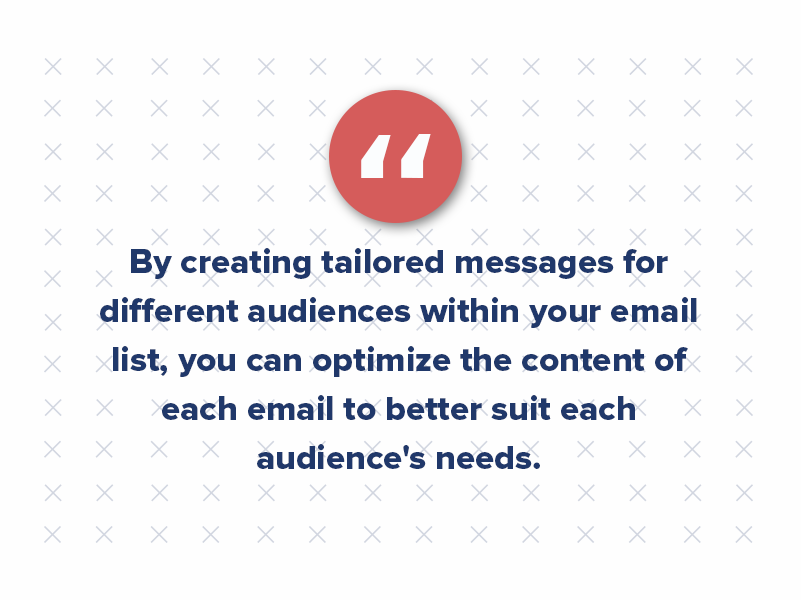
For example, once your email list is large enough, you’ll want to segment the list by current, prospective, engaged, non-engaged, etc.
3. Monitor your email marketing analytics.
Email marketing should be tracked closely to see what is and isn’t working for your email campaigns. You should track metrics such as open rate, click-through rate (CTR), email forwards, and unsubscribes to understand your email campaigns’ performance better.
Statistics show that email marketing continues to be one of the most successful multifamily digital marketing tactics. Email marketing has significantly risen in recent years. According to Campaign Monitor, email open rates have increased by 6% from 2020 to 2021, and email click-through rates increased by 9%. And email open rates in 2022 average 21.5%; typically, open rates between 20% and 40% are viewed as average.
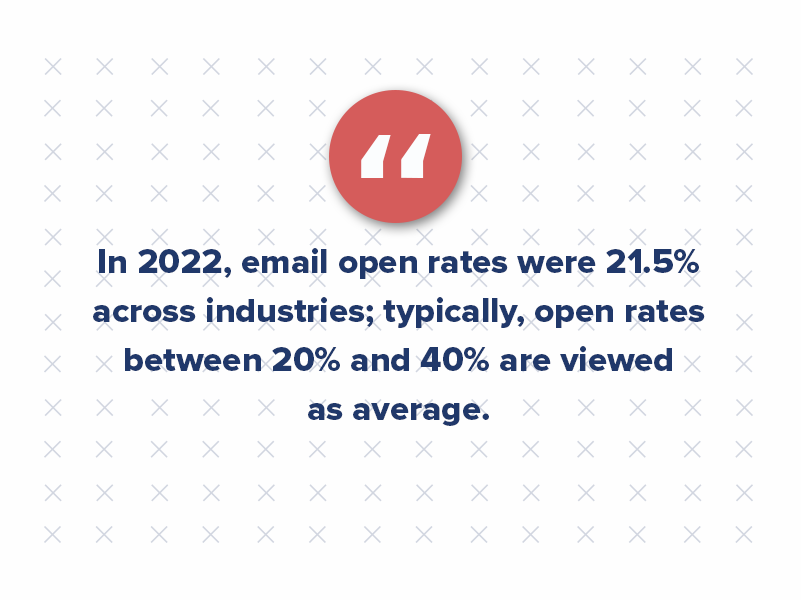
This clearly indicates that email marketing is becoming an increasingly effective way for businesses and apartment communities to reach their residents.
Pay close attention to email open rates to determine the success of your subject lines. To determine your open rate, divide the number of unique opens by the number of emails sent minus those that bounced. Although it’s not always exactly accurate, open rates provide a good gauge of your engagement over time. If your open rate starts to dip, it’s a sign that you need to review your subject lines or sending frequency.
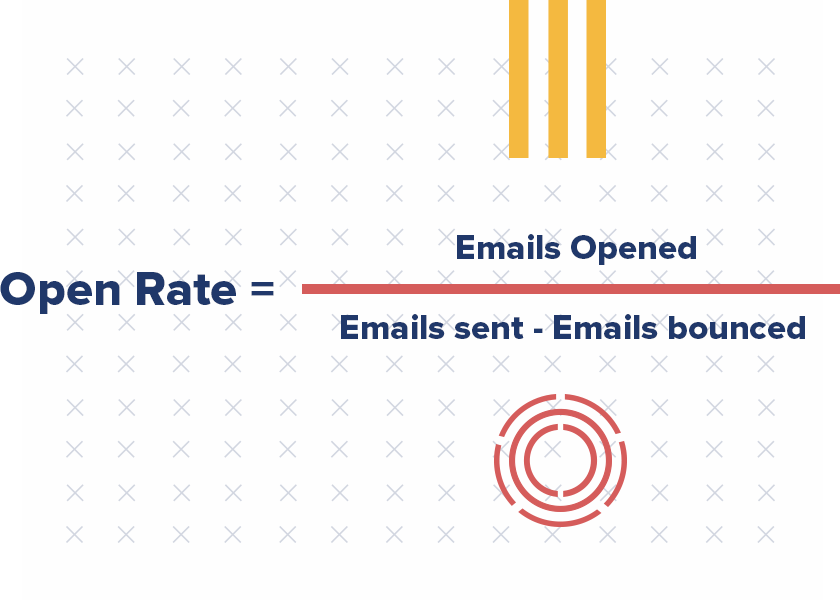
4. Pack your emails with high-quality, relevant content.
Never (and we mean NEVER) send an email to send an email. Writing quality content that resonates with your target audience is essential for email marketing success. Ensure that emails are well written and offer valuable information to readers so they will open them in the first place.
It’s also important to ensure that content is properly displayed on different devices, including mobile phones and tablets since most people now access their emails via their phones.

5. Don’t stress about your email design.
Email design matters too. But not in the way you think it does.
Designing visually appealing emails with engaging images and colors CAN help keep your email list engaged, but you need to determine what is best for your audience.
What we mean by this is that you don’t always need a fancy email design to build, maintain, and grow a successful email campaign. We’ve tested this theory with designed and visually appealing email newsletters vs. a plain text html email we send to our list. In every occurrence, our email open rate and CTR were higher with the plain text email.
Our theory? People are inundated with emails every single day. Emails flood your inbox and the designed sales emails typically end up in the spam folder. Or, if the person opens it, they quickly delete it if something (the content) doesn’t grab their attention immediately.
Html text emails feel and look more personal. We started sending these emails to our list from one team member. It’s sent as a one-on-one email exchange and garners more engagement than a highly designed email.
So, next time you plan your next email campaign, we recommend A/B testing a designed email vs. html text to see what works best for your audience.
6. Subject lines are critical.
First impressions matter and that’s exactly what a subject line is. It’s arguably the most important part of your email and should talk almost as long to perfect the subject line as it does to write the whole email.
Attention-grabbing subject lines will encourage people to open your emails instead of sending them straight to the trash bin. We treat subject lines like a landing page: Keep it straightforward, pique your audience’s interest, and don’t overwhelm your audience.
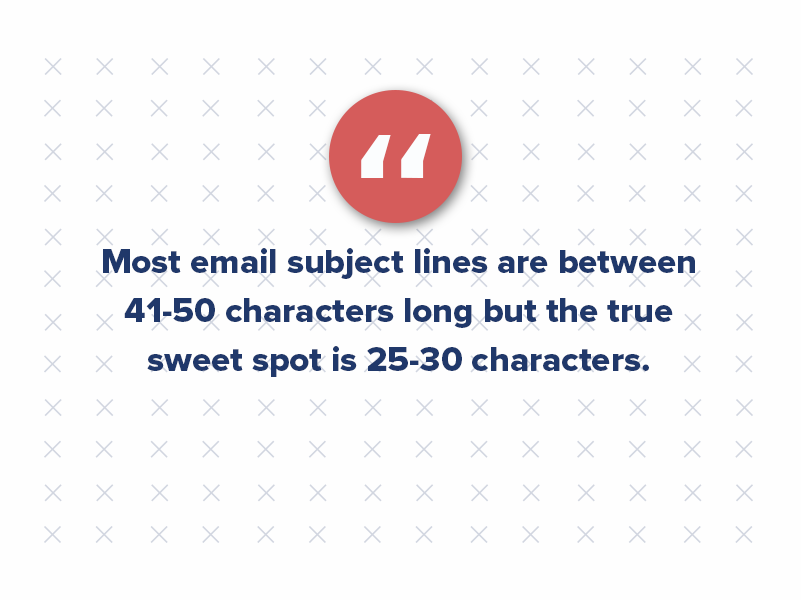
Here are a few things we’ve learned from A/B testing email subject lines:
- 60 characters MAX or no more than 9 words.
- Most email subject lines are 41-50 characters long, but the true sweet spot is 25-30.
- Punctuation is not needed.
- Sentence case is favorable.
- Emojis can be added but they should be done with intention.
- Emojis at the beginning of your subject line tend to perform better than at the end.
Our most popular subject lines:
- 3 keywords for more lease traffic
- 🚨Property SEO mistakes to avoid
- Win Yeti merch in 5 minutes
- Potential renters will love to see THIS
- Are you using this type of ad?
- This will keep leads on your website longer
- Increase open rates with this 1 tip!
After 4 months of A/B testing email subject lines, we’ve increased our overall open rate per email from 10% to 20%. Specifically, our five best-performing subject lines all had an open rate of 25%-30%.
7. Invest in email marketing automation software.
The final tip we suggest when it comes to email marketing is email automation. Automating email campaigns can save apartment communities time and money while also providing a more personalized experience for users. The key here is to provide targeted content at specific times to maximize the impact of your email marketing campaigns.
You can use platforms like Campaign Monitor, MailChimp, SharpSpring, HubSpot, and many more to help you automate your emails. The goal of automation is to make sure no lead is forgotten. You can create email workflows triggered when someone signs up for a property tour, fills out a contact form on your multifamily website, or clicks on a link in one of your email blasts.
Email marketing software will also make tracking your analytics and A/B testing content a breeze.
Get the Most Out of Your Email Campaigns
Email marketing can provide great results for apartment communities — if done correctly. Email offers an incredible opportunity to engage with current residents, attract prospects, and build renter loyalty.
By following email marketing best practices and taking advantage of email tracking data, you can get the most out of your campaigns and see positive outcomes for your property.
4 Things You Likely Didn’t Know About Multifamily SEO
There is no shortage of competition within Google’s SERPs in the real estate industry. As you niche into subsections on real estate, the competition becomes even tighter. Property management companies in the multifamily space must fight tooth and nail to reach the top of Google’s rankings and keep their position. With such intense competition amongst property managers online, you must have a clear plan on how to master SEO. The more relevant keywords your multifamily website shows up for, the more potential business you ultimately interact with.
Today, we will bust four surprising myths about multifamily SEO that you might be uncertain about.

1. No-follow Links Don’t Matter
Since many people within the multifamily SEO space would argue that backlinks are the most important ranking factor, it makes sense to start here. The last time that you had the opportunity to get a no-follow backlink pointing back to your site, did you accept? It is a myth that no-follow backlinks carry zero weight. There have been statements made in the past from people within the SEO space that no-follow links don’t pass domain authority. Many people stop here and don’t look any further.
While no-follow links do not pass domain authority, they do pass other great SEO signals that can help your apartment website. Additionally, large website publications like Business Insider only give out no-follow links. Suppose your property management business gets a link from Business Insider talking about how great and relevant you are to the multifamily industry. In that case, Google will see that as a great thing! You’re likely to experience a boost in rankings even though the link is set to no-follow. Although they don’t pass direct authority, plenty of other SEO benefits are passed, making these worth pursuing.
2. Viral Content Isn’t Worth Chasing
Google considers website traffic a huge ranking factor when ranking real estate companies. One way to get a huge surge of traffic is to create a viral piece of content. For example, property management companies of large multifamily buildings have created a funny, parody-style music video showing their property to potential tenants. Another common example of creating viral content is when people need to sell a house in the luxury real estate market. Real estate professionals will record flashy drone footage highlighting a mansion sitting on a massive estate. These eye-catching, memorable videos ultimately draw traffic to the website, which helps boost apartment SEO.
The cherry on top of making viral content is when the content is relevant to the local community where your property is. Not only will your multifamily website catch real, local traffic by legitimate internet users on legitimate IP addresses, but you also may generate a few apartment leads from it. Attempting to create viral content seems overwhelming at first. It’s hard to know where to start. If you can crack the code and generate something truly special, you will boost your multifamily website’s rankings and generate apartment leads.

3. No One Reads Anymore
The myth has some truth to it. Many people do not read anymore. However, some people surprisingly still do. That’s why creating meaningful, relevant, and useful content on your apartment website is important. Your goal is to create useful guides that address the needs of your target audience. Offer solutions to their needs, or at least useful perspectives, through engaging content.
You don’t have to only use words for your content. Switch things up and include videos, infographics, and other engaging features that you can include on a page. This will help keep users on your multifamily website from bouncing. If people leave pages once they arrive, it signals to Google that your site might not be that good. Keep your content relevant, engaging, helpful, and diverse.
4. Pictures Don’t Matter
A picture says one thousand words, right? Pictures matter in SEO for several reasons. The quality of the photo is important to gain trust and credibility once someone hits your site. If you’re using too many stock photos, that will turn people off, and they will likely bounce. Add photos of your property to help encourage people to rent from you.
Pictures also play a role in your local SEO efforts. Google picks up geotags from photos depending on where they were taken. Depending on how the image was transferred, saved, edited, or added to the site, it could remove the geo-tag. For property managers that want to show up for local keywords, it’s important to have geo-tagged photos throughout your multifamily website. That tells Google, in the background, that you are a legitimate, local business and not a scammer.
Multifamily SEO Is a Moving Target
No matter how much you dial in your multifamily SEO efforts, new algorithm updates will emerge, and things will change. Google has a great way of keeping multifamily marketing professionals on their toes. As you dismiss myths within the online space, new ones will arise that you’ll be forced to create an opinion on. Test and measure things as often as possible without breaking your website. This will help you improve your website’s health, SEO, and rankings.

Jenn is an experienced writer for the real estate industry and a house flipper. If she’s not swinging a hammer, she’s either writing about different real estate topics or reviewing investment property opportunities.
How to Convert Apartment Leads Into Leases Using Your CRM
Sales are all about converting apartment leads into residents. And a CRM (customer relationship management) system can be an invaluable tool for making that happen for your property.
You can improve your chances of converting leads into leases by tracking apartment leads and resident interactions. Key features to look for in a CRM include apartment lead management, multifamily email marketing automation, and contact management.

Apartment lead management is important for monitoring prospects and keeping track of their progress. Multifamily email marketing automation can help you nurture leads with automated email campaigns. And contact management can help you keep track of resident interactions and follow up with them effectively.
When it comes to multifamily marketing, these CRM features can be extremely helpful in booking more property tours. By using a CRM system, you can better manage your apartment leads, automate your email multifamily marketing, and keep track of resident interactions. This will all lead to more sales and a higher conversion rate.
That being said, not all CRMs are created equal. Some CRM features are more helpful than others when it comes to conversions.
Here is a closer look at what our team views as the most important CRM features for conversions (and what we use every day in our multifamily marketing efforts!):
1. Customizable lead capture forms
A good CRM will allow you to create custom lead capture forms that fit your needs. This is important because you want to ensure you’re capturing all the information you need from potential customers to follow up with them effectively.
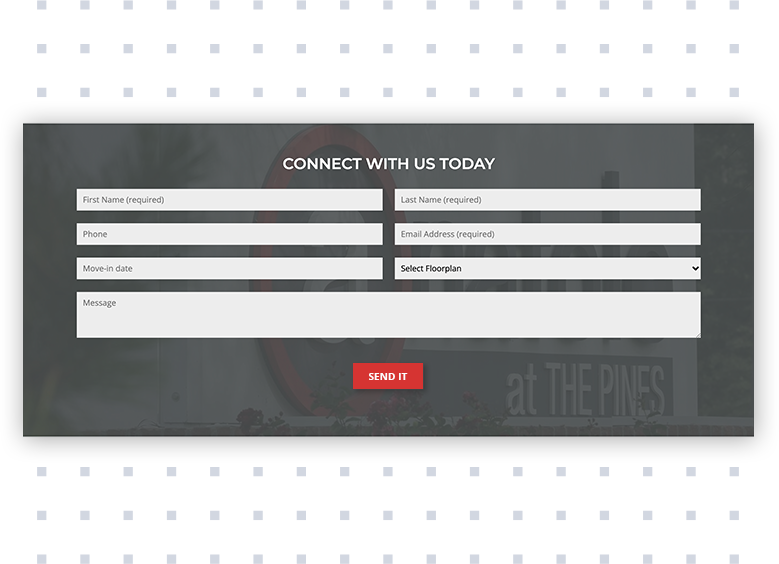
Custom lead capture forms are online forms that allow you to gather leads for your multifamily property. By collecting contact information and other key data points, you can nurture leads through the sales process and ultimately convert them into residents.
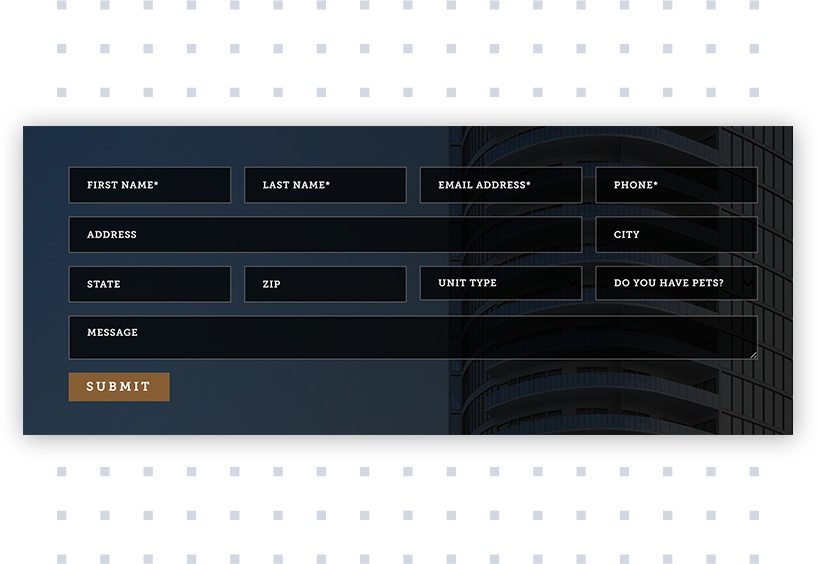
There are several features that can be included on custom lead capture forms, but some of the most important for conversions include the following:
- Property type: By asking leads what type of multifamily property they’re interested in (e.g., apartments, townhomes, etc.), you can ensure that you’re marketing to the right audience.
- Budget: Collecting budget information helps you qualify leads and determine whether they can afford your multifamily property.
- Location: Knowing where your apartment leads are interested in living helps you target your multifamily marketing efforts and ensure that you provide relevant information.
- Contact information: To follow up with leads, you’ll need to collect their contact information (e.g., email address, phone number, etc.).
By including these key data points on your custom lead capture form, you can increase the likelihood of conversion by ensuring that you’re marketing to the right audience and providing relevant information.
2. Lead scoring and grading
A lead scoring system will help you determine the most promising leads, so you can focus your energy on converting them. This is important because it allows you to prioritize your time and resources and increase your chances of making a sale.
If you have access or interest, marketing automation software offers lead scoring to qualify your apartment leads. Lead scoring involves tracking any lead in your CRM across your multifamily website. With lead scoring, you can ascribe value to different blogs or page views, offers or email interactions. When a lead reaches a certain score, decided on by your team, they become sales qualified.
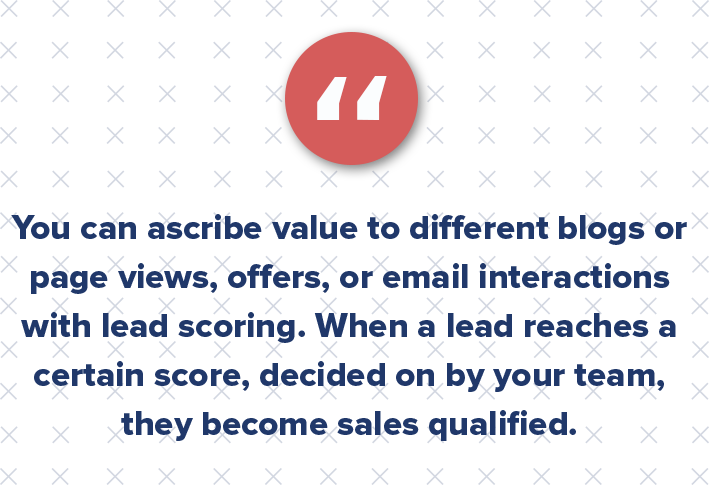
3. Automated follow-up
Automated follow-up is one of the most valuable features a CRM can offer. Once an apartment lead has been captured, it’s important to follow up with them as quickly as possible. An automated follow-up system will ensure no potential sale slips through the cracks. It allows you to set up automatic email or phone reminders to follow up with apartment leads, so you never miss an opportunity to convert them.
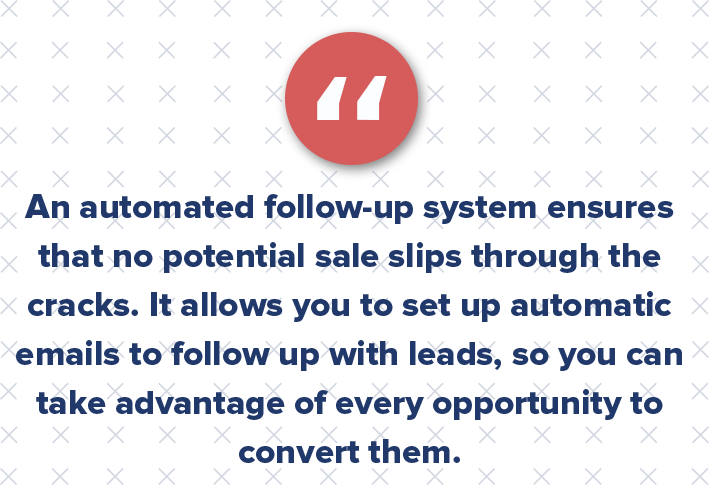
For example, you will want to set up automated follow-up emails for anyone who fills out a form on your multifamily website to book a tour, contact your leasing team, or if they download any of your free resources.
Don’t forget to use personalization tokens in the body copy of your email to ensure your message is catered to the specific resident. However, be cautious with personalizing your subject lines, as recent studies found that emails with personalized subject lines get lower open rates (18.79%) than those with generic ones (22.14%). Further, the personalized subject line click-through rate was 1.74% versus 2.74%.
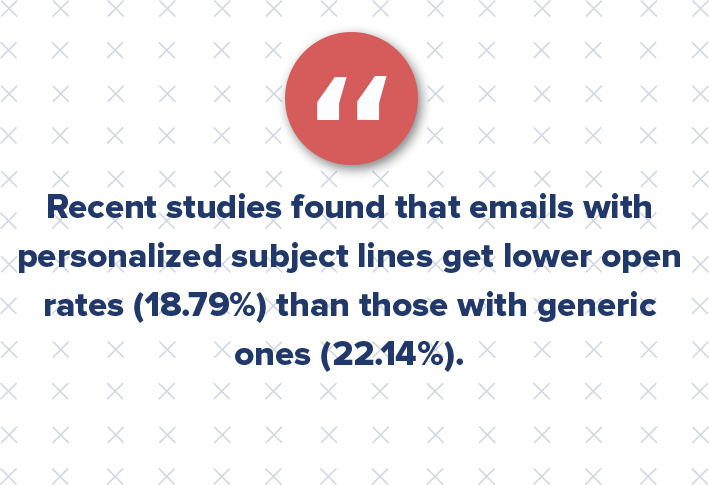
4. Detailed customer profiles (AKA get to know your prospects)
The more information you have about a resident, the better equipped you are to provide them with what they need and want. A detailed resident profile will include contact information to lease history and interests.
This profile can also help you refine your resident buyer persona. Potential residents should never be looked at as an entry in a database or a contact in a CRM. Multifamily marketing messaging is meant to connect and provide powerful content that is useful and relevant to their problems. All the while, it’s helping transform your properties through real and honest data.
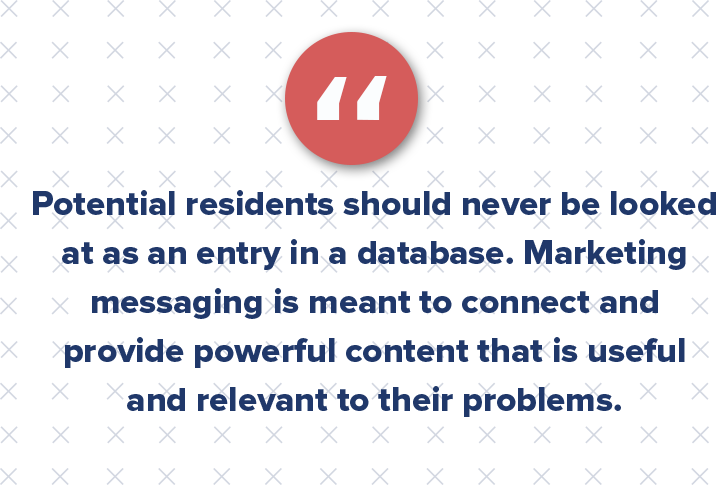
What renters perceive is reality to them, which is why it is important to ensure your residents feel comfortable and welcome at your property. This requires properties to anticipate the needs of community members, and the best way to do that is to get to know them.
Qualifying your apartment leads to increase conversions
Just because a lead is sales-qualified does not mean they are a good fit. As a multifamily marketer, you’ll likely never know if a lead meets sales’ needs. That requires sales to engage with the lead first. Instead, it’s imperative to use lead qualification methods to ensure your apartment leads are qualified from a multifamily marketing perspective and ease sales jobs on the rest.
With the right CRM tool and marketing automation software, you can more easily determine who your hot leads are and take action, so no sales fall through the cracks. Or, you can use this information to nurture those leads to eventually become leases. Ultimately, with the right tools, you’ll be well on achieving your leasing goals.

The Secret to a Successful Multifamily Marketing Strategy: Influencer Marketing
Millennial and Gen Z renters no longer consider commercials or ads the major influence in their decision-making process. Many brands know this, using their marketing tactics to focus on influencer marketing to reach beyond the typical leasing billboard.
From reviews to thought leadership, social media for apartments offers a unique outlet to build fans as an influencer. Social media influencers in the real estate world are recognized for their large following and insights covering all aspects of the multifamily space.
A strong social presence is necessary to hold an influencer status in addition to quality posts. Turning to these influencers as a voice within the industry will result in valuable relationships that companies can leverage.
So who exactly are these valuable assets?
Social media influencers are users with a large following and are “influencing” the community. They are often viewed as a more trustworthy resource than advertisers, thus better capturing an audience.
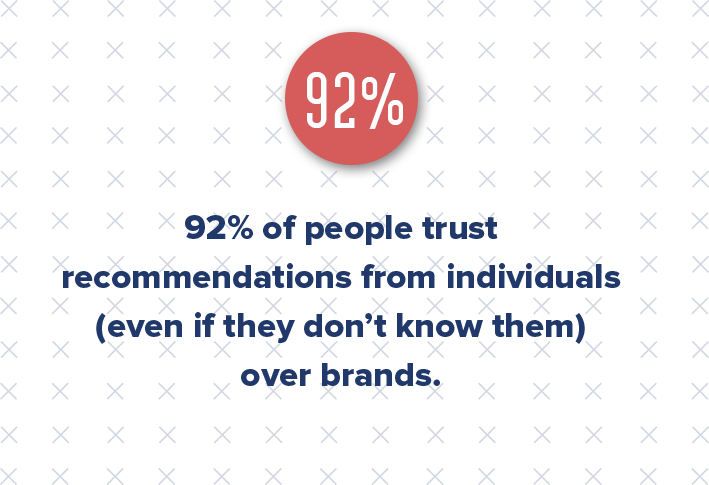
According to Nielsen, 92% of people trust recommendations from individuals (even if they don’t know them) over brands. It makes sense, right? Who sounds more reliable, a brand trying to sell you something or an individual just stating opinions?
Influencer marketing has become an increasingly important tool for businesses in recent years, and the multifamily industry is no exception. Influencers are social media users with a large and engaged following who can help to promote your brand or product. When done correctly, influencer marketing can be an extremely effective way to reach new prospects and generate apartment leads.
What does influencer marketing mean for multifamily?
As property managers take to more nontraditional methods for reeling in renters, social media influencers hold an interesting opportunity for multifamily. Influencer marketing is an indispensable asset as it allows a third party to promote your property.
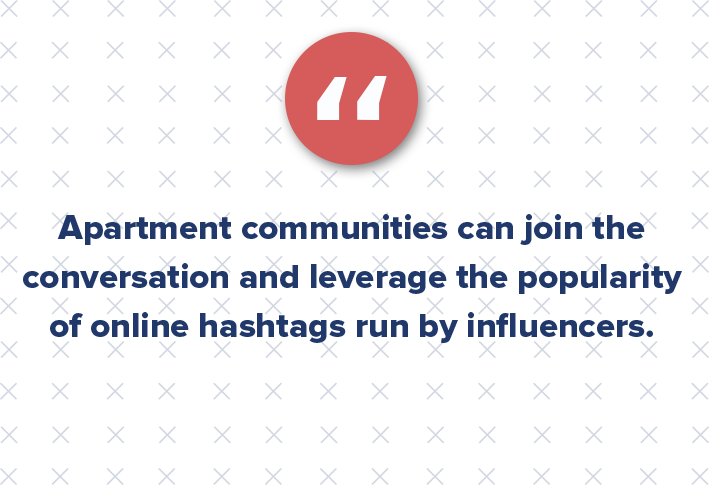
For instance, influencers have brought attention to properties through guest blogging and social promotion, like TweetChats. Most of them participate or host weekly Tweetchats, like #AptChat and #REOnline, where real estate professionals exchange ideas while networking. Apartment communities can join the conversation and leverage the popularity of online hashtags run by influencers.
Leveraging influencer marketing for your property
There are a few key things to remember when leveraging influencers for social media.
- First, it’s important to identify influencers who are a good fit for your multifamily brand and who have an audience that overlaps with your target market.
- Second, you’ll want to develop a clear strategy for working with influencers, including what type of content you’d like them to create and how you’ll promote it.
- Finally, ensure you measure the results of your influencer marketing campaign to continue improving your multifamily marketing strategy over time.
Connect and Engage With Influencers
Connecting with real estate professionals is the first step to becoming aware of how influencers can help your marketing. Engaging with these professionals in relevant topics will help develop a network that can be used to get involved with the community.
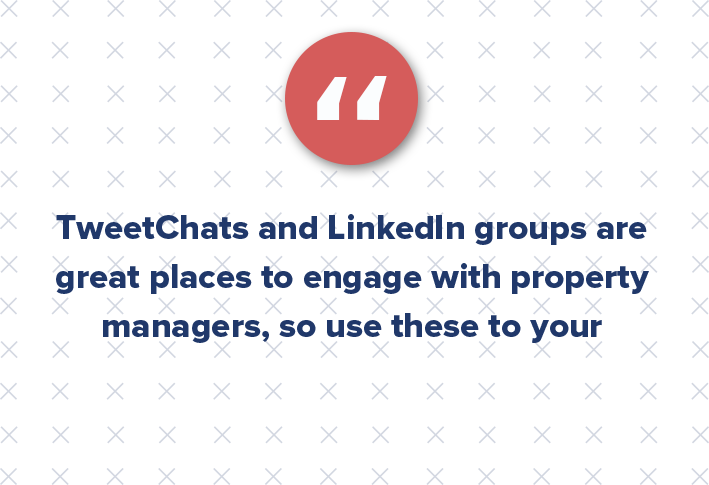
Twitter, Pinterest, and LinkedIn have a large commercial real estate community, so it’s important to know where to go to connect with the right professionals. TweetChats and LinkedIn groups are great places to engage with property managers, so use these to your advantage. As long as you’re getting your name out there, other professionals will start to see you as a reputable source.
Socialize With Quality
Focusing on sharing quality content is important to real estate influencers. Social media should be an outlet for property managers to be themselves and talk with other professionals. Sharing relevant content and using popular real estate hashtags will elevate your presence. Further, voicing opinions on certain trending topics will show a positive interest in building an active, involved community.
Boost Your Multifamily Marketing Efforts
Influencers are great marketing tools because they know the ins and outs of the industry. Connecting with these professionals allows property managers to market their property simply by becoming visible to their followers.
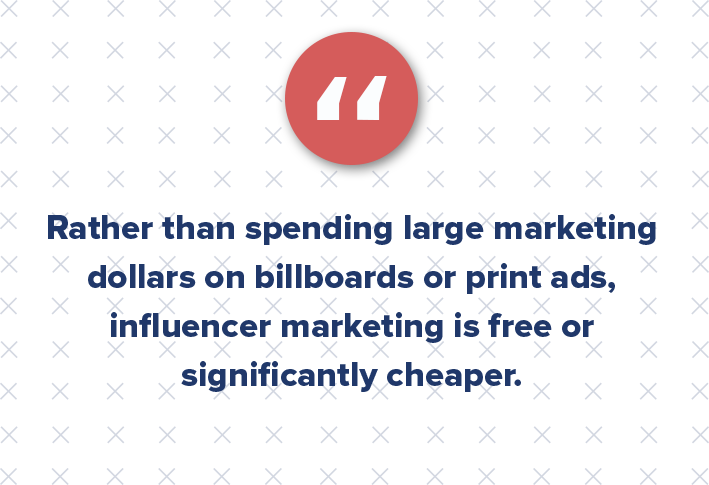
Rather than spending large marketing dollars on billboards or print ads, influencer marketing is free or significantly cheaper. Consider allowing one of these professionals to guest blog on your property’s site, for example. They can share your article with their followers, and you have more content to add. It’s a win-win!
By following these tips, you can maximize the impact of influencer marketing for your multifamily business.
Understanding the Relationship Between Multifamily SEO and Social Media
Did you know that multifamily SEO matters on social media?
More and more multifamily properties are hopping on social media, which serves as another channel for them to share and interact with renters and the community. But perhaps you don’t see the appeal of a social media presence?

Well, we’re here to give you another very important reason to be on social media, and that’s search engine optimization (SEO). Multifamily SEO is essentially the process of optimizing your content for search engines.
For most platforms (i.e., Instagram, Facebook, Twitter, Pinterest, and Tumblr, to name a few), there are a few simple steps you can take to move your multifamily property up in search engine rankings:
How do you optimize your social media profiles?
1. List Basic Information
All social media platforms have a place for users to list basic information: Company Name, Location, About Us, Address, etc. Make sure to fill out all the information sections on your profiles with specific keywords. The more information you share, the more chances you have to be indexed by Google. Besides, you want to make sure that anyone who comes across your property online knows exactly where it’s located and how to contact you.
2. Anticipate Popular Keywords
Brainstorm words or phrases that are relevant to your multifamily property. Perhaps it’s “lofts in downtown Dallas” or “Houston apartments with a dog park.” What is your property or multifamily business offering? What would your target audience search specifically? Use these keywords at a high density throughout your social media profiles and bios; include them in your social media captions when it’s natural to do so. You also might want to use them in hashtags (within the caption and not the comments) to get users on social media to find you more easily.
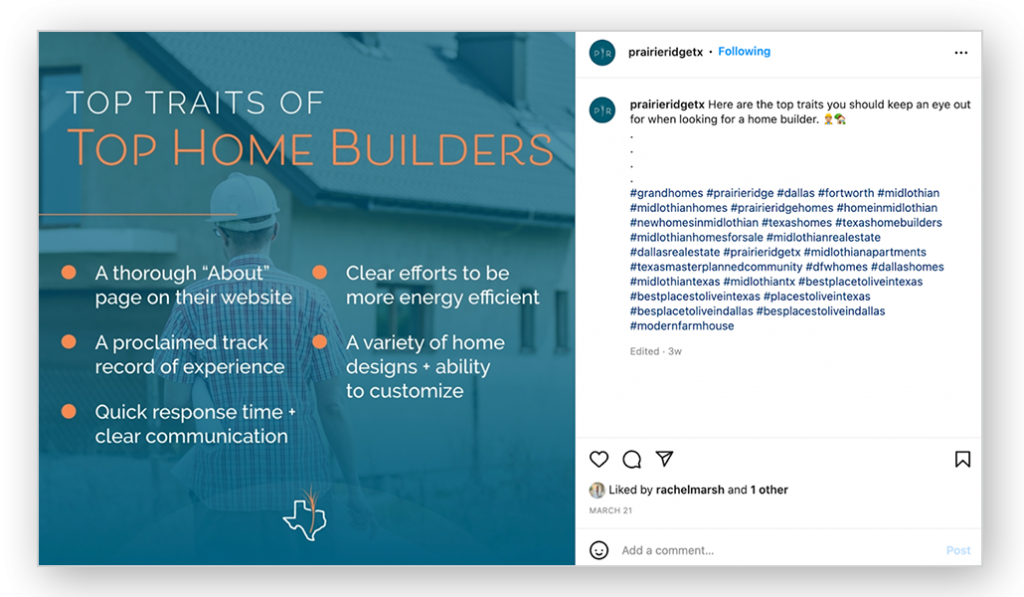
3. Invite Reviews
Display a section for reviews when possible. Facebook pages have a review section on the left side panel with 1-5 star ratings for the user to evaluate and post comments. It shows real people living in your multifamily property, providing real feedback. Again, it’s more opportunities to be indexed by search engines. This also allows you to publicly address any issues that your residents may be having, ultimately showing potential residents that you’re on top of handling problems.
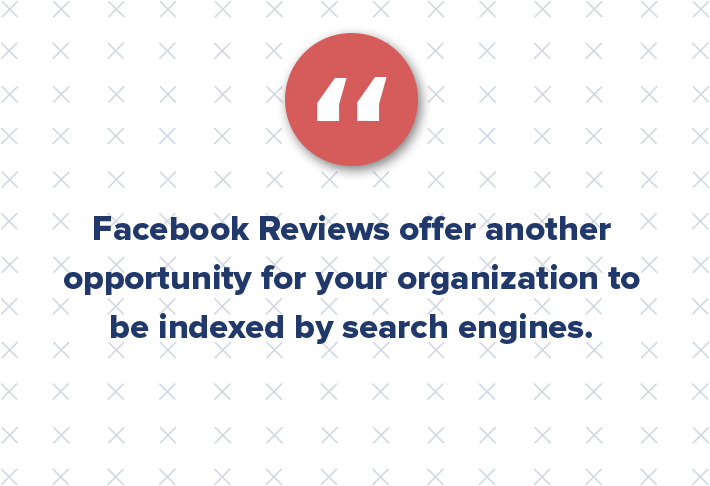
4. Link Often
Outbound links are one of the most important aspects to multifamily SEO, so be sure to link to other sources! In your use of social media, provide links to relevant blog articles and neighborhood events. Spread the word out about the great happenings going on around your neighborhood and property. Not only is it good for multifamily SEO, but “linking” is a great way to connect with people and businesses in your community.

5. Create Shareable Content
Inbound links are equally as important to SEO, yet you have to earn them. When people link back to your multifamily website or social media pages, it means you’re sharing content that is high quality, compelling, and helpful.
Some ideas include:
- Make and share a weekly newsletter with information about what’s going on at your property.
- Post interior design tips for small living spaces.
- Write about apartment decorating and storage hacks.
- Promote local events and happy hour specials in your community.
Creating shareable content starts with knowing your audience and what they would find interesting and resourceful.
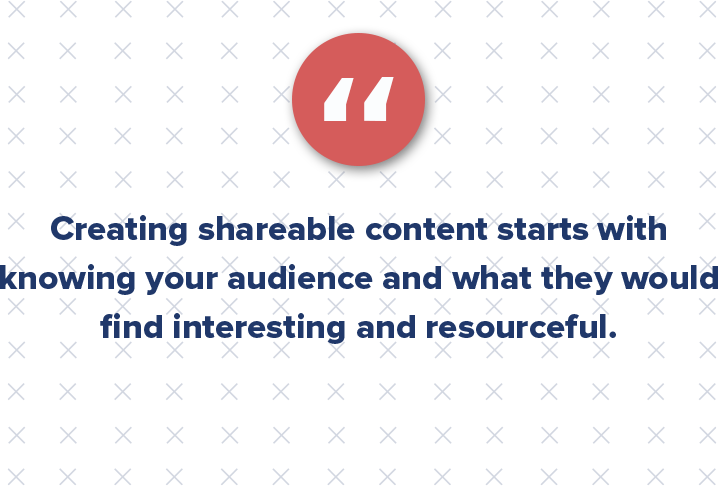
6. Utilize Multifamily PPC
While SEO is the organic approach to driving traffic, multifamily PPC is the paid. PPC ads display at the top or in the sidebar of search engine results. A successful multifamily PPC campaign combines your keyword research and your insights to design highly targeted ads that drive traffic to your website. It’s important to note that well-qualified traffic is the result of research and continued testing. Understanding your residents should be an ongoing learning process and the foundation of any SEO or PPC campaign (not to mention, all digital marketing).
7. Update Your Instagram Bio
Potential renters don’t just use Google to find new apartments, they use Instagram too. They go to the search bar on the explore page a type in “apartments in [city]” and maybe even include a descriptor such as “affordable” or “luxury.”
The way you give your property’s account the best chance of showing up in a related search is by adding keywords right into the “Name” of your profile’s bio. While the label for this section might make you assume you’re limited to just having your property’s name, there are actually no rules for this section. You can put whatever you want for your bio’s name. There’s also quite a bit of space you have to work with.
Here are some examples:
- Rio Villa Apartments | San Angelo, TX
- LVL 29 | Luxury Apartments in Plano
- Willow Creek | Affordable Apartments in Austin
- Prairie Pride | New Homes in Midlothian
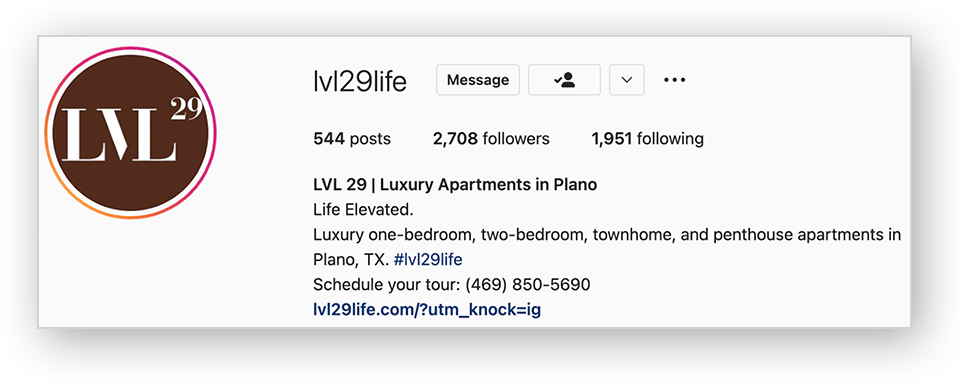
If you feel like your Instagram handle is enough to communicate the name of your property, you could even remove the name entirely and focus more on longer or multiple keywords.
Following these simple steps is a great way to improve your search engine ranking with the social media platforms you’re already using. It ultimately makes your content easier to find, allows you to connect with your audience, and helps you build the brand that you’re striving towards.

Creating Marketing Qualified Leads With the Right Form
The excitement of starting an inbound marketing strategy for your organization can lead to initial eagerness to get things rolling. But in that sprint to kick off your multifamily marketing, you might find yourself missing a step or two.

The use of content to gather apartment leads is, without a doubt, the primary focus of inbound. Therefore, many marketers and property managers spend their time emphasizing content strategy to generate those apartment leads.
However, optimizing your content without optimizing your lead strategy defeats the purpose of inbound altogether. Instead, marketers should spend much of their intro to the inbound process on apartment lead generation and business strategies to guarantee their content is meeting objectives.
What is the purpose of an apartment lead generation form?
Nearly every multifamily website these days has an apartment lead generation form. But the effectiveness of those forms depends on many factors, including:
- Type
- Location on the page
- The offer
- The questions
- How the contact data is used
Have you ever been interested in a new apartment complex or shopping center around town? Maybe you had a specific question while they were in development, so you filled out the contact fields — and waited. And waited. But no one got back to you.
Chances are, you provided a decent amount of personal information on that apartment lead generation form. You did so willingly because it was an exchange you found reasonable: your contact details for the offer or answers you wanted. Understanding this exchange is the key.
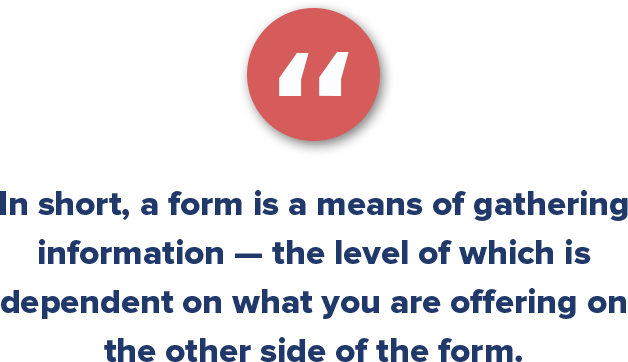
In short, an apartment lead generation form is a means of gathering information — the level of which is dependent on what you are offering on the other side. In multifamily inbound marketing, forms are also a means of progressive profiling (i.e., qualifying your apartment leads by asking for a little more intel) each time they fill one out. This progressive profiling is meant to get more and more information that qualifies leads by lifecycle stage and determines their point in the buyer’s journey.
What questions should you ask on your apartment lead generation form?
Now that you know the importance of your fields, the next issue becomes, “What questions should I ask?” This is where your apartment lead generation strategy comes in. If you followed the multifamily inbound marketing strategy correctly, your teams all came together to identify your buyer persona. Doing this should have resulted in defining your lead lifecycle stage.
If you have not done this, go back and do it now because this data is vital to your progressive profiling.
Let’s say you are a tenant representative for a large new commercial office building downtown. The project is not complete yet, but it has generated a lot of buzz, and companies are showing interest. You want to be sure you lease up before opening. However, you also need to make sure the companies you bring in are a good fit. This is where progressive profiling comes in.
Your first apartment lead generation form (the awareness one) will always cover introductory information. This includes the basics:
- Name
- Phone
- Company name
- Job title
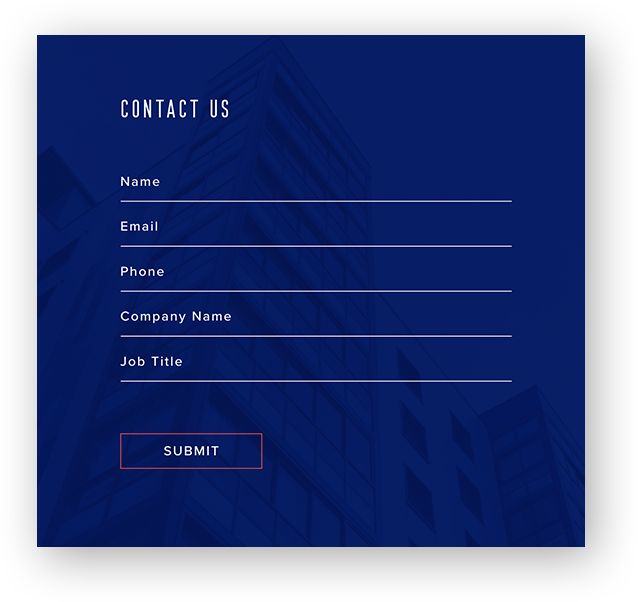
If you are using certain marketing automation software like HubSpot, you have the opportunity to add smart fields that will populate if you already have this particular information. Smart fields help expedite the lead qualification process by letting you ask for additional relevant information. These fields also make things easier for sales down the line if the lead becomes “sales qualified.”
Developing your questions
Gathering your teams together for your apartment lead generation strategy would be pointless if you don’t have a process by which to direct them. Thankfully, that process is relatively simple. Early in the multifamily inbound marketing process, your team should have come up with an ideal buyer profile and a buyer persona, as well as SMART goals for the year to determine what type of leads you are hoping to attract. Need help building your ideal buyer profile? Check out our other blog here.
At this time, you get to bring all those details together. By using lead and customer goals, persona details, and sales data, your team should be able to determine the necessary lead information to create marketing-qualified leads.
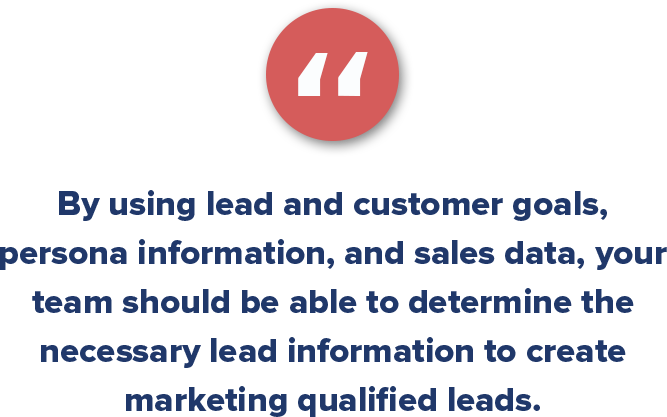
Back to the tenant rep example from above. You know the office building in question has a specific number of spaces with an anticipated rent range. You also know the amenities that the building does and does not have. Given the nature of the building, along with your business goals, you know you will likely need to build a large awareness funnel to meet the occupancy goals by open.
While your awareness questions are simple enough, the details you need in the consideration and decision stage are much more in-depth. For one, the type of business and size is important in determining fit, as the building may not support the needs of certain companies. If the building is high-end, questions around “current rent” or “monthly revenue” may be important to help you discover if the company is a good fit from an affordability standpoint. By gathering this information early on, when it comes time to start leasing, the tenant rep’s job should be fairly simple in picking sales-ready leads that met the requirements.
Segmenting your list
While the ultimate benefit of progressive profiling is to shorten the sales cycle, there’s a secondary benefit that can help. List segmentation is the act of separating contacts in your CRM by various criteria. If you run a multifaceted business with a lot of different verticals, list segmentation is a lifesaver.
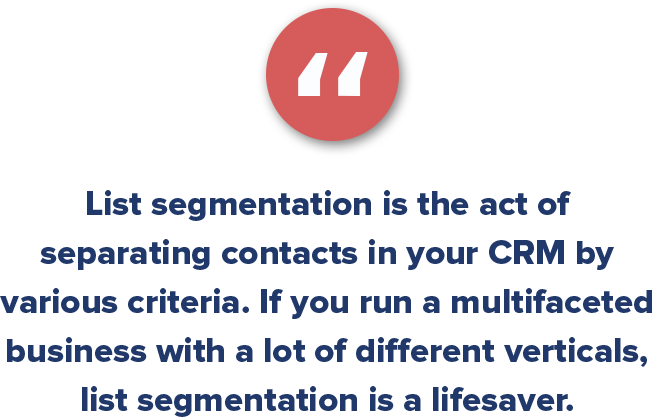
If you have a new offer for clients in the senior living space, for example, you don’t want to send it to the people in the economic development of mixed-use developments. Furthermore, people interested in your ad services probably aren’t interested in what you offer in multifamily branding. By gathering this information from apartment leads, you can use it to segment your multifamily marketing for a more streamlined message.
For content marketing success, an apartment lead generation form is much more complex than slapping a few fields on a page. Forms require a certain amount of business strategy to be used for their optimal effectiveness. This is a powerful tool that can improve the life of your sales cycle while requiring little more than some upfront strategy. All it takes is asking the right questions.
How to Build, Measure, and Scale Your Multifamily Marketing Approach
When most real estate developments begin to create their multifamily marketing strategy to attract marketing-qualified leads, you can imagine that the conversations are more or less the same each time.
Namely discussions on ad buys, billboards, large banners, and sales calls. These methodologies are often inefficient, having little ROI and little reach in meeting business goals.
A key reason these methods are inefficient is that multifamily marketing has changed.

For many years, marketing was based on interruption through things like cold calls and advertising. But as society became more digital — from the VHS and DVR allowing people to fast forward to programs like AdBlock preventing ads from displaying on websites — these methods have become inefficient.
Technology has empowered consumers to take the buyer’s journey online; therefore, your multifamily marketing efforts should be online too.
How is multifamily marketing evolving?
The better question is, how are residents evolving? Whether you like it or not, millennials (and now Gen Z renters) comprise a sizable chunk of the multifamily market.
Millennials rent longer and by choice, and their lifestyles are vastly different than generations before. Trends like pet ownership and hyper-connectivity define this generation, along with a willingness to sacrifice square footage for prime locations.
And yet, while these lifestyle trends drive development, they’re only a starting point for multifamily marketing.
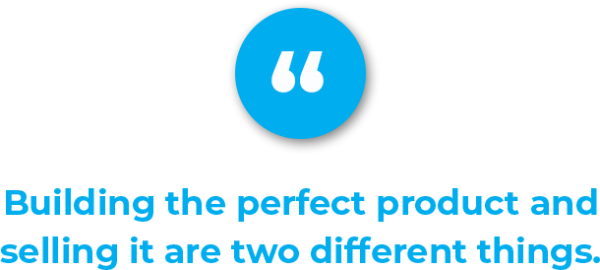
Here are a few secret keys to attracting and converting web visitors into marketing-qualified leads for your multifamily business:
1. Giving every property or organization a custom approach.
Development and the creative process should cater to the audience — not the other way around.
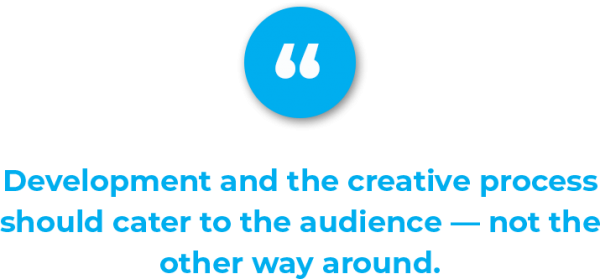
Let’s start by really understanding the target demographic for your property or organization. Immerse yourself in understanding their lifestyle, pain points, and interests. Bring in a multifamily branding agency that can help you turn insights into a concept that will remain top of mind throughout the development process, from contractors to vendors, from building to multifamily branding.
Customizing your apartment marketing approach is essential in today’s world. Marketing strategies vary per market because each market is remarkably different. It would be ignorant to believe that Lincoln, Nebraska residents want the same things as residents in Charlotte, N.C, for example.

2. Creating a narrative and telling your multifamily brand story.
With an earnest understanding of your target audience, a narrative about your residents should unfold. Their motivations, lifestyle choices, and demographic characteristics should come together as a story. From these insights, the concept for your property will be born.
Focus on building something that inspires the people living there. Watch a car commercial, and you’ll see how well the auto industry understands this concept of storytelling. It’s not so much about the product as the lifestyle it promotes.
This aspirational lifestyle affects every facet of multifamily development — from site selection to design and multifamily branding.
When it comes to differentiating your property, it starts with knowing your audience better than they know themselves. Only through thoughtful research can you begin to develop the environment, the lifestyle, and the creative messaging that resonates (and ultimately generates marketing-qualified leads).
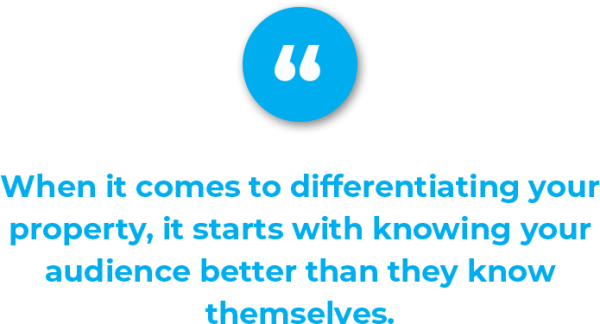
3. Building your digital marketing funnel.
What’s the first thing you do when you’re looking to buy something? Odds are, you do some research on Google first. This is where apartment marketing begins in the modern age. As everything moves online, the internet has become the source of major information exchange.
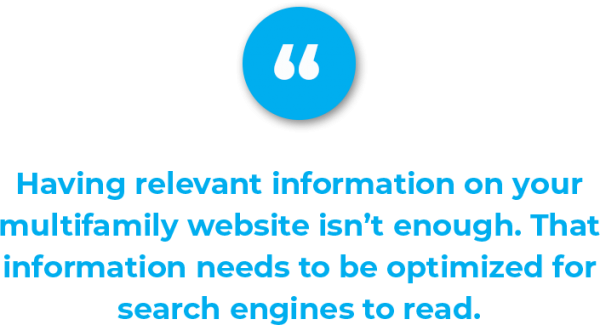
What keywords should you be using? Well, imagine what your typical buyer is searching for. If you’re looking to attract people to your blog about real estate developments in Dallas, you shouldn’t mention attractions in Chicago. From there, the information needs to be broad enough and address the buyer persona’s problem in a way that drives interest.
The information should exist as a content offer and will be “gated” so that the visitor will complete the relevant information to download it. That information turns the visitor into an apartment lead.
These apartment leads might then consume more relevant information and provide more sales information to become marketing-qualified leads, and so on. This is called building the multifamily marketing funnel, and this funnel ensures that leads are qualified before reaching sales. This methodology also sees apartment leads being pulled in to ask questions and do research rather than pushed and bombarded by unwanted advertising messages.
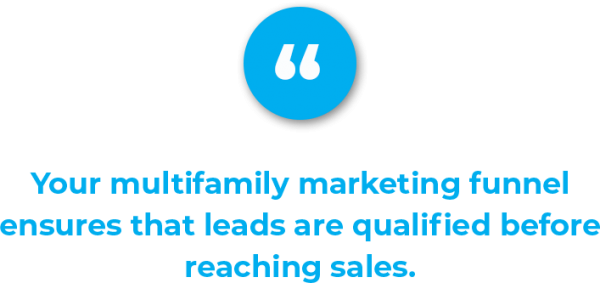
Why is this significant? Because not only are you spending less on obtaining these types of leads, but these marketing-qualified leads are more likely to convert, minimizing your overall ROI.
4. Tracking how you are featured online.
You need to build the funnel to be successful with your apartment marketing to ultimately generate more marketing-qualified leads. The next issue is making sure that you’re presenting this information well. As we stated before, it’s not enough to exist online. Your presence needs to be in tip-top shape!
Why, you ask? Because first impressions are important on the web. People will leave your site within 5 seconds if they cannot find the information they want. So how do you make sure you’re relevant?
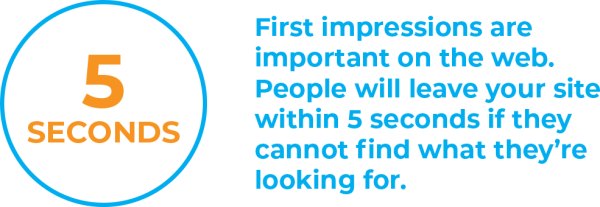
Keywords
Ensure you’re using accurate multifamily SEO keywords that your customer will search. You want to feature these regularly enough that search engines will map your content but not so much that they’ll dock you for keyword stuffing.
Focused Content
Staying relevant with your content — including linking to other trusted sites and keeping your information objective — is key to keeping consumers on your site. When a consumer feels like they’ve stepped into an infomercial on your homepage, they’re likely to leave. However, if you keep your content focused and informative, from blogs to social media posts, consumers will more likely see you as an authority and keep coming back.
UX Multifamily Web Design
People are tempted to go with style over substance in multifamily web design. Contrary to what your boss might believe, multifamily websites should always be designed for the consumer and with their interests in mind. What does that mean? The consumer doesn’t want to hear about you. They want to hear about how you’re going to solve their problem.
Keeping your content and multifamily web design consumer-friendly makes consumers more likely to stay on the site. This includes making the site ADA-compliant for your user too. Mobile-friendly designs are here to stay, so make sure your site cooperates.
The Future of Multifamily Marketing
With these aspects implemented, you can expect an improved search presence and a lead ROI that can deliver substantial returns.
This is the future of multifamily marketing. Rather, this is the roadmap for building brands in today’s world to bring in more marketing-qualified leads, and this industry has finally got its hands on it.

Most apartment marketing professionals have a complicated relationship with email marketing. Receivers are continually overwhelmed by their overflowing inbox while senders are frustrated by the lack of responses. Truth be told, it is hard to avoid the spam folder these days.
That said, email marketing is still the most effective way to reach and nurture apartment leads.

According to Marketing Sherpa, email is the preferred source of business communication for 72% of consumers. Whether you are nurturing apartment leads through promotions, interests, or top-of-the-mind contact, email is the way to go.
So, how can you make sure you send a really stellar email? What is the secret to getting your email opened, and — more importantly — read?

As you develop a lead nurturing strategy, there are key components to remember:
1. Define the goals of your apartment marketing outreach.
Who is your target audience? Why are you reaching out to them? The goal here should be to send clear and well-defined messages to a specific audience. Figuring out who they are and where their interests lie is the key to understanding which type of nurturing strategy to implement.
Additionally, it is just as important to define the reason for your outreach. Are you looking to generate some foot traffic and tours at your property with leasing specials? Or, perhaps you are seeking new residents who have toured but have not committed yet.
These scenarios entail two different kinds of apartment leads and each requires its own form of nurturing. The commonality is the overall approach. You want to send targeted offers and content-specific emails to engage on a personal level.
2. Make your email marketing personal.
Sending frequent automated emails can irritate your recipients. Not to mention you will find yourself in the spam folder faster than you hit send. Adding personal touches to your emails guarantees a higher success rate.
According to Experian, brands that personalize their email subject lines experience 27% higher unique click rates and 11% higher click-to-open rates.
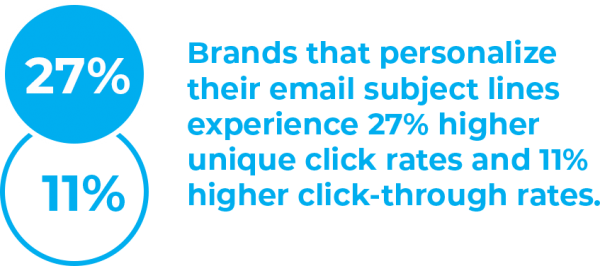
Implementing a practice as simple as using your apartment lead’s name in the greeting makes a big difference. By tailoring your emails to a prospect’s interests, actions, and behaviors, you are sending recipients something that they will want to read.
This is especially important in the commercial real estate or multifamily space. Personalized apartment marketing allows you to keep returning clients in the loop while simultaneously reaching out to new prospects.
3. Send emails with valuable apartment marketing content.
One surefire way to pique a lead’s interest is to saturate your emails with information that they want to know. Send content that is relevant and valuable to your apartment leads. For example, share helpful apartment hacks or storage tips with prospects and share fun events and leasing specials with your prospects.
Focus on your lead’s problem point and position your property as the solution. The key to providing educational content is to focus on one topic per email. This gives your recipients a specific course of action to follow. Multifamily properties, for example, can use this nurturing strategy by sending emails that educate prospects on the neighborhood or highlight unique amenities.

4. Connect with your apartment leads on multiple platforms.
Engaging with residents on various types of media keeps you actively present and part of their daily lives. Connecting beyond the initial email exchange is a great way to keep in touch and achieve top-of-mind awareness.
Some digital ways to engage with apartment leads include:
- Invite them to subscribe to your blog
- Connect on LinkedIn
- Share links to your company’s social media pages
- Encourage prospects to share your email or social media content
Engage Your Apartment Leads to Grow Your Property
Getting the lead is important. But it is what you do with your apartment leads that really counts. Nurturing your prospect through email marketing is the best way to connect with a lead and turn it into a lease. Integrating these tips into your apartment marketing strategy will further engage your apartment leads and grow your property.
Gone are the days of a “set-it and forget-it” website. To truly engage your audience you need to know how to write a blog that speaks to them. Business blogging is not just a trendy thing to do, it actually is good for your bottom line.

Consider the following statistics:
- 81% of consumers trust advice and information that they read in blogs.
- Nearly 96% of bloggers promote their service business blog posts via social media.
- 57% of marketers say they’ve gained customers specifically through business blogging.
- Companies who blog receive 97% more links to their website.
- Using images in blog posts gets 94% more views.
In a world where digital consumption is king, there is only one way to fight the battle against your competitors — business blogging and distributing your content for all the world to see.
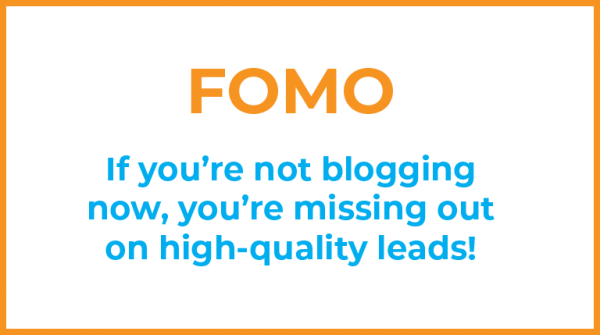
Below, our experienced team of content writers at our multifamily branding agency compiled all of our best business blogging tips for writing and distributing a service business blog.
1. Select your platform
Prior to starting your blog, you must first decide which business blogging platform you would like to use. Some free options include WordPress, Blogger, and Tumblr. However, if you do not care for any of these, you can always search for other business blogging platforms via Google. If you are a business, you should consider hosting a blog within your website in addition to an outside blog site. Through your external blog, you can create inbound links that drive traffic to your company’s website and in turn, means free advertising!

2. Decide on a web design theme
The next is choosing a web design theme for your business blog. Some bloggers like to talk about the industry, others focus on common problems that clients have. One great way to write about solutions to the problems that your customers have is to predict the questions your prospects are Googling.
If you already have your buyer persona built, predicting your customer’s questions and pain points will be a cinch! If not, refer back to some of our previous blogs for simple steps on how to accomplish this.
3. Pick your design template
Now that you have your theme, it’s time to think about the layout and color scheme of your website. Do you want it to be clean? Simple? Elegant? Fun? Creative? Whatever you choose keep your readers in mind, and make sure that there is a synergy between your design and web theme.
If you operate in the multifamily industry and want a beautiful, affordable, and easy-to-implement web theme, be sure to check out our sister company Swifty!
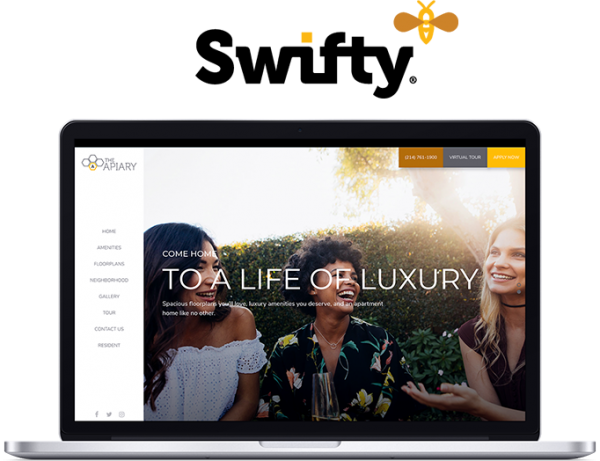
4. Create a content calendar
Once all of this preparation is complete, it’s time to create an editorial calendar. You’ll want to begin by mapping out at least 3 to 6 months at a time. Then, make notes on the calendar for each day you want to post content.
Most importantly, stick to the calendar! Make sure that you create an editorial calendar that is reasonable for your schedule. Do not overwhelm yourself — it will be hard to stick to your goals if you over-commit and in turn will discourage you from writing future content.
However, you should challenge yourself — don’t schedule just one service business blog a month. Once you get into the groove, you will see that you can post more often and the boost in SEO, engagement, and traffic will make it worthwhile.

That being said, your business will struggle if you don’t have a system in place to attract the right kind of audience with the right content at the right time. Your goal is to nurture and convert your audience, not drive them away because you are shelling out the wrong content (and too much of it).
So press pause before pumping out eight articles a day without defining your business goals first. Create a content strategy that will attract your buyer persona and improve their experience.

5. Write away!
Finally, now that you’ve established your blog site, designed your theme and layout, and developed a content calendar, it’s time to put your fingers to the keyboard and write your first business blog.
At first, keep it simple. If you’re not sure how to get started, read through a few established competitor blog sites. Get a feel for the voice you want your service business blog to have.
Research your customers’ pain points and choose topics that will answer their most pertinent questions. Try to keep in mind what your customers are searching for online so that you can position your organization as a trusted resource.
The length of your blog will depend on your buyer persona and their interests, but we typically recommend a blog post length of at least 1,200 words to get the most out of your SEO strategy. The key for your business is to research your persona and conduct interviews to learn what type and length of content are most valuable.
Interested in more tips for creating a highly optimized blog for your business’ SEO? Check out this blog for step-by-step business blogging tips!

How to Distribute Your Blog Content to Reach the Right Audience
Many of our clients ask us about the importance of content marketing and whether they should consider starting a service business blog. Our answer is always a resounding yes.
Not only is consistent content marketing integral for SEO and achieving a higher search ranking, but it’s also a great way to position your business as an expert resource to customers.
However, distributing content is more important than writing content. In fact, promoting a blog can often take more time than writing the actual content. This is particularly true for businesses that do not have a corporate team of writers and marketers on hand.
To make the blog worth the time and effort of your team, it’s critical to distribute the content effectively and obtain as much use from the blog as possible. For example, a single blog post can be shared on Twitter with a snappy headline, extended to Instagram with an engaging image, and adapted to a shareable infographic.

Below are a few ways you can get the most bang for your blog:
Organic Distribution via Social Media
One of the biggest perks of social media as a marketing channel is the ability to create an engaged, online community of the individuals that build up your target audience.
- Social Sharing Buttons — Allow your website visitors to read your content and share it with their friends. The not-so-savvy internet users, or even the lazy ones, will rarely copy your URL and post it on their social pages, so make it easy for them to share your content.
- Business Social Accounts — Share all of your blogs through your social accounts. Write a one-line teaser that will encourage them to click on the link and include a blog graphic to give your audience a visual representation.
- Connections — Connecting with influencers in your respective industry is important to building a solid blog following. Find people on social media that you know will be interested in your content and reach out to them so they can have easy access to your service business blog.
Email Marketing Distribution
Like your RSS Feed, you should encourage your website visitors to subscribe to your email list. Once you capture those email addresses you can send out monthly newsletters that feature your most relevant blog posts and drive traffic back to your website.
Content Syndication
It’s important to build relationships with relevant blogs, brands, or publishers. This ultimately builds your brand and makes your blog awareness a lot higher than others. Asking others to link to your content in return for you linking back to their content gives you a connection that benefits both parties. This strategy is very important because it allows other bloggers to endorse you and build a bigger audience.
Paid Distribution
Paid advertisement distribution on Facebook is fairly simple to use and necessary in today’s digital marketing world. Digital marketing gets difficult when organic reach on Facebook decreases, so use paid distribution to your advantage.
Reshare Regularly
Not all of your potential customers are online or on the same social channel at the same time. Additionally, a customer might have read your article the first time and forgot to save it or forward it along to their co-worker. For these reasons, it’s essential that you reshare your content regularly across your social media and even in your newsletter.
Include an “In Case You Missed It” section in your newsletter that highlights previous popular blogs. Choose several one-line teasers or important quotes from your article and schedule tweets throughout the month. Adjust the ad set and re-run your Facebook ad to get your content in front of an even broader audience.
Make It Visual
Infographics provide significant value from a content-supporting standpoint. Companies are constantly generating content, but the bulk of it is often heavy and wordy. Focus on utilizing the visual aspect of infographics to break up the content. Pull important statistics and tidbits of information from your in-depth service business blog and build out an enticing infographic that users can easily download and view.
Additionally, pull out some other short quotes or statistics to create an eye-popping graphic that you can share on Instagram and Pinterest. Considering you cannot share links in your Instagram posts, prompting users to click the link in your profile is a great way to promote your service business blog.
Making the Most of Your Business Blogging
Business blogging is no easy task, but with these tips in mind, you are well equipped to make the most of your time and effort by expanding the reach of your content.

Despite the economic tribulations brought on the U.S. in the last few years, the real estate industry is hot. Aside from the increasing demand for more homes and commercial spaces, the multifamily industry is expected to grow remarkably up until 2030. So, how can you harness some of this data in your multifamily content marketing?
Let’s discuss …

A report from the National Multifamily Housing Council (NHMC) and the National Apartment Association (NAA) states that demand for multifamily real estate will be so great that at least 4.6 million units will be constructed within the next decade.
However, to make the most of these promising forecasts, multifamily real estate companies must learn to optimize data when creating multifamily content marketing.
Why Data Is Crucial in the Multifamily Industry
Data is crucial in every industry as it can improve conversion rates, increase traffic, and prevent knowledge gaps. To illustrate, a Bain & Company study states that businesses in the U.S. could increase profits by over $2 billion annually by utilizing data. Thus, data literacy is integral to professionals — including those who don’t work in the data analytics field.
In fact, today’s business degrees are becoming more interdisciplinary, covering topics like contemporary technologies and data methods. Modern online bachelor’s in business administration even have concentrations in data analytics and management information systems, which are taught alongside traditional business concepts, such as accounting, management, and business law. This shift only shows the growing expectations placed upon business people to be more data literate.
And this translates to the multifamily industry as harnessing data effectively can lead to more intimate understandings when it comes to trends, more accurate insights into future movements, and more effective multifamily content marketing creation.
How to Integrate Data Into Your Multifamily Content Marketing Strategy
1. Use data to drive contextual storytelling.
Good communication should paint a vivid picture, even if the topic is technical. After all, consumers need to understand the material for it to be impactful. However, multifamily marketing campaigns must also present information that audiences can relate to or find use in to have a lingering effect. This is where gathered data comes in. Using soft and hard data, you can create a well-rounded customer story that provides context, evidence, and insights. Thus, when crafting multifamily content marketing for your customer story, use data collaborations to maximize relevancy.
2. Leverage data visualizations.
Nothing hypes an exciting data set more than visuals. Though some data diehards may disagree, the truth is that visualizations make data more appealing and digestible. In fact, a study by iScribblers found that humans process visuals 60,000 times faster than plain text. Thus, should you have any pertinent data that needs sharing, explore doing so via infographics, interactive tables, or even videos.
Aside from being more immersive and interactive, data visualizations can increase recall value by upwards of 65%, making it a critical medium in data dissemination, externally and internally.

3. Only pick the most salient data points.
Although publishing every bit of data you gather may be tempting, the best way to share them is to circulate the most notable highlights in your multifamily content marketing. This benefits you two-fold. First, more succinct datasets allow you to retain an audience’s attention span (only eight seconds). And, second, shorter data — and content, in general — is more digitally compatible.
Considering that mobile compatibility and software development is credited by 59% of those in the multifamily industry for improving customer service, it’s also no surprise that there is now a demand for software programmers with a degree in computer science. However, whatever platform you use, your audience won’t be engaged if you present them with a hodgepodge of figures and statistics.
In line with this, data expert Dr. Stephanie Evergreen told Forbes that “cutting to the chase” with your findings is a better way to engage the 50% of audiences who view such content on their mobile devices.
Although experts agree that the real estate market’s long-term future remains unclear, the influence of multifamily content marketing and the power of data is undeniable. As multifamily businesses aim to adjust to the New Normal, data-enriched content can act as an anchor and a propeller for industry stability and profit.
Selena Perkins is a freelance digital marketer, with a keen interest in data analytics. She believes that knowing how to use data to make decisions is a must-have skill for everyone. When she’s not busy with work, Selena unwinds by watching shows on Netflix.


